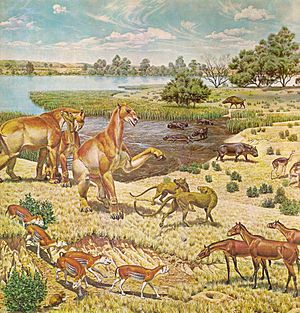Neogene facts for kids
The Neogene Period was a time in Earth's history that started about 23 million years ago and ended around 2.6 million years ago. It's part of the Cenozoic Era, which is sometimes called the "Age of Mammals."
Before the Neogene came the Paleogene Period. The Neogene itself is split into two main parts: the Miocene Epoch and the Pliocene Epoch. After the Neogene, we entered the Quaternary Period, which is the period we are still in today.
Contents
What Was the Neogene Period?
The Neogene Period was a time of big changes for Earth's climate, geography, and the living things on it. Continents continued to move into their modern positions, and new mountain ranges formed. This period saw the rise of many modern animal and plant groups.
Climate and Geography
During the Neogene, Earth's climate generally cooled down. This cooling led to the growth of ice sheets at the poles, especially in Antarctica. As the climate changed, so did the landscapes.
- Mountain Building: Many of the world's major mountain ranges, like the Himalayas, Alps, and Andes, continued to rise during this time. This was due to the slow but powerful movement of Earth's tectonic plates.
- Ocean Changes: The oceans also changed. The closing of the Tethys Seaway (an ancient ocean) and the formation of the Isthmus of Panama (connecting North and South America) had a big impact on ocean currents. These changes affected global climate patterns.
- Grasslands Spread: The cooling and drying climate helped grasslands spread across many parts of the world. These open areas became important new habitats for animals.
Life During the Neogene
The Neogene Period was a time of great diversity for life on Earth. Many of the plants and animals we see today have their roots in this period.
Animals of the Neogene
Mammals continued to be very successful and diversified a lot during the Neogene.
- Mammals: Many modern mammal groups, like horses, camels, deer, and elephants, became more common and evolved into new forms. Early ancestors of humans also appeared during the later part of the Neogene.
- Birds: Birds also continued to evolve, with many modern bird families appearing.
- Marine Life: In the oceans, marine mammals like whales and seals became more diverse. Sharks, including the giant Megalodon, were top predators in the seas.
Plants of the Neogene
The spread of grasslands was a major plant-related event during the Neogene.
- Grasslands: Grasses became very widespread, creating new ecosystems. This was important because many grazing animals evolved to eat these grasses.
- Forests: While grasslands spread, forests still existed, especially in warmer and wetter regions. Many modern tree types were present.
The Miocene Epoch
The Miocene Epoch lasted from about 23 to 5.3 million years ago. It was a time when Earth's climate was generally warmer than today, but it started to cool down towards the end.
- Animal Life: This epoch saw a huge increase in the number and types of mammals. Many modern mammal families appeared, including early forms of bears, dogs, cats, and rhinos. Apes also became more diverse and spread across Africa and Eurasia.
- Plant Life: Forests were still common, but grasslands began to expand significantly, especially in North America.
The Pliocene Epoch
The Pliocene Epoch followed the Miocene, lasting from about 5.3 to 2.6 million years ago. The climate continued to cool, leading to the formation of more ice at the poles.
- Land Bridges: The formation of the Isthmus of Panama during the Pliocene connected North and South America. This allowed animals to move between the two continents, leading to a "Great American Biotic Interchange."
- Early Humans: This epoch is very important because it's when the first hominins (early human ancestors) appeared in Africa. These early humans started walking upright.
- Modern Animals: Many animal groups that are still around today, like modern elephants, deer, and cattle, were present during the Pliocene.
See also
 In Spanish: Neógeno para niños
In Spanish: Neógeno para niños


